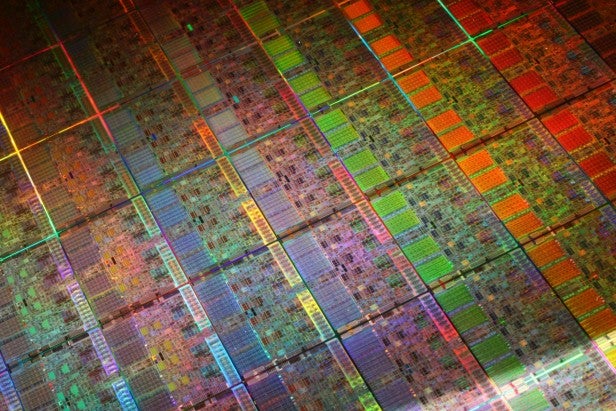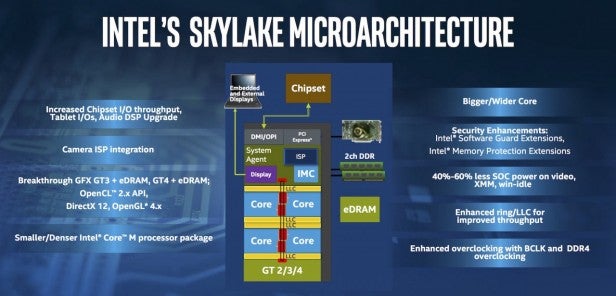Intel Core i3-6100 Review
Intel Core i3-6100
This sub-£100 Skylake chip takes the fight to AMD - and Intel's own silicon

Sections
- Page 1 Intel Core i3-6100 Review
- Page 2 Benchmarks Review
- Page 3 Performance and Verdict Review
Verdict
Pros
- Fast single-core performance
- Low power requirements
- Skylake for under £100
Cons
- Can’t compete in multi-core benchmarks
- A little slower in some games
Key Specifications
- Review Price: £94.00
- Two-cores with Hyper-Threading
- 3.57GHz clock speed
- 6th generation Core, Skylake architecture
- 14nm manufacturing process
- 3MB cache
What is the Intel Core i3-6100?
Skylake is Intel’s latest processor architecture and, not surprisingly, it debuted in expensive quad-core chips: the Intel Core i5-6600K and Core i7-6700K took the lead.
Now, though, a full range of dual and quad-core processors is available, starting from the £95.99 Core i3-6100T. The Core i3-6100 sits just above that entry level model, coming in at £98.99. It’s only a dual-core part but crucially it runs at a fairly rapid 3.7GHz and it includes Intel’s Hyper-Threading technology for improved multi-threaded performance.
The upshot is a processor that might be ideal for those looking to build a fast rig but that don’t need the multi-core power of a quad-core – believe it or not that’s actually most of us, including gamers.
Intel Core i3-6100 – Specs and Design
The Core i3-6100 is a full Skylake processor – not just a renamed older generation part. As such it has a host of new features, most of which you can read about in our full Intel Skylake review.
The main jump over previous generation chips, though, is that the manufacturing process has improved from the 20nm of Haswell (4th generation Core) to 14nm, and upgrades to the silicon are designed to improve performance while reducing the amount of electricity required.
Related: The Best Graphics Cards
This is still a lower-end chip though, so there are some compromises. The most obvious limitation, aside from there only being two cores is that Core i3 parts don’t have Turbo Boost.
That means they can’t dynamically overclock to run at higher speeds. In contrast, something like the Core i5-6400 can Turbo Boost from its 2.7GHz base clock to 3.3GHz, while the i5-6600K can tweak itself to a top speed of 3.9GHz.
However, that’s part of the secret to why the i3-6100 may be ideal for some users, as it already runs at 3.7GHz even without Turbo Boost. That’s pretty fast and, as most programs and games are still single-threaded, single-core speed is still the dominant factor in day to day computing.
Nonetheless, there are a few other areas where the i3-6100’s cost-saving is clear. It’s not a K-edition chip so doesn’t have an unlocked multipler for easy overclocking – it will overclock a bit but it’s much more difficult. Halving the number of cores also means it only has half the amount of L2 cache, from 1MB to 512KB, plus its L3 cache is only 3MB. That’s 1MB less than some of the more expensive Core i3 chips and half as much as the Core i5 chips.
The latest i3 is equipped with the Intel HD Graphics 530 integrated core. The 530 variant sits in the middle of Intel’s new integrated range, and it’s got 24 execution units and a clock that runs between 350MHz and 1,050MHz. This is another area where the Core i3 could overhaul more affordable Core i5 chips like the i5-6400. That CPU has the same HD Graphics 530 GPU, but it’s held back to a top speed of 950MHz.
Thanks to only having two cores, the i3’s power requirements are modest. The i3-6100 has a 51W TDP, which compares well with the 65W or 91W required by different Core i5s. Rival AMD chips, meanwhile, require 95W or 125W.
The Core i3’s £94 price puts it right between the £90 AMD A10-7700K and A10-7850K, which costs £99.Both AMD parts are unlocked, so they can be overclocked, and both have impressive specifications elsewhere. The former part runs at between 3.4GHz and 3.8GHz using AMD’s boosting technology, and the latter ranges between 3.7GHz and 4GHz. Both have four native cores, both have more L2 cache than the i3-6100, and both have variants of AMD’s Radeon R7 graphics – the cheaper chip has 384 stream processors, and the pricier part has 512 stream processors.
The Core i3-6100 also faces competition from AMD’s FX processors. The closest competitor is the FX 6350, which costs £99 and has three cores that can address six concurrent threads. That chip has 8MB of L3 cache and a 3.9GHz core that can overclock itself to 4.2GHz, although it’s not unlocked for manual overclocking. Spend a little more and the £114 FX 8320 Black Edition arrives: an unlocked, quad-core chip with a 3.5GHz core and a 4GHz top speed. Note, though, that AMD FX chips don’t have any integrated graphics.
Buy Now at Amazon.co.uk from £92 | Amazon.com from $117.99
Intel Core i3-6100 – The Skylake Ecosystem
Skylake doesn’t just herald a new range of processors – Intel has released a new socket and chipset alongside these chips. The wealth of new hardware is a double-edged sword: it means upgrading to the new processors is more expensive, but it ushers in a range of new features.
The Z170 chipset makes several key changes designed to future-proof PCs. It has many more PCIe 3.0 lanes than previous chipsets – 20 in total – which means there’s more bandwidth available for graphics cards, PCIe-based storage devices and Thunderbolt peripherals.
Related: The Best Intel Z170 Motherboards
There’s more support for USB 3.0, better networking options, and Thunderbolt 3.0 debuts here – along with better overclocking options. Support for DDR4 memory is also included.
There are other chipsets that have more restrictive feature sets. Parts like H170, B150 and H110 don’t support multiplier-based overclocking, and include fewer USB 3.0 connections. They also have lesser support for PCIe 3.0 slots, with fewer lanes – and some don’t support RAID options for storage.
The arrival of a new socket and chipset also means the market is flooded with new motherboards. Even the cheapest new boards have more features than older models, from PCIe 3.0 slots to M.2 SSD connectors. They also tend to have more USB 3.0 (including the latest Type-C versions) and SATA connectors too – perfect for taking advantage of Z170’s bandwidth improvements.
Z170-based boards aren’t cheap. The most affordable PCBs start at just over £80, and for that money you’ll get a more basic feature set: fewer PCIe slots and USB connectors, less likelihood of M.2 storage support, and a more modest backplate. At the top end of the market are extreme gaming and overclocking boards that cost over £200 – they come with every port, slot and connector imaginable, as well as on-board buttons, displays and overclocking features.
Boards with the H170, B150 and H110 chipsets are far more affordable. Slabs with the H110 chipset cost less than £60, and most boards with H170 and B150 come in under £100.
This does mean that costs can add up once a new motherboard is added to the mix – but the Skylake ecosystem still compares well to AMD’s offerings. Its A-Series APUs and FX processors don’t support DDR4 memory, for starters. The A88X chipset included on most APU boards also lags behind on USB 3.0 ports and PCI-Express 3.0 lanes.


